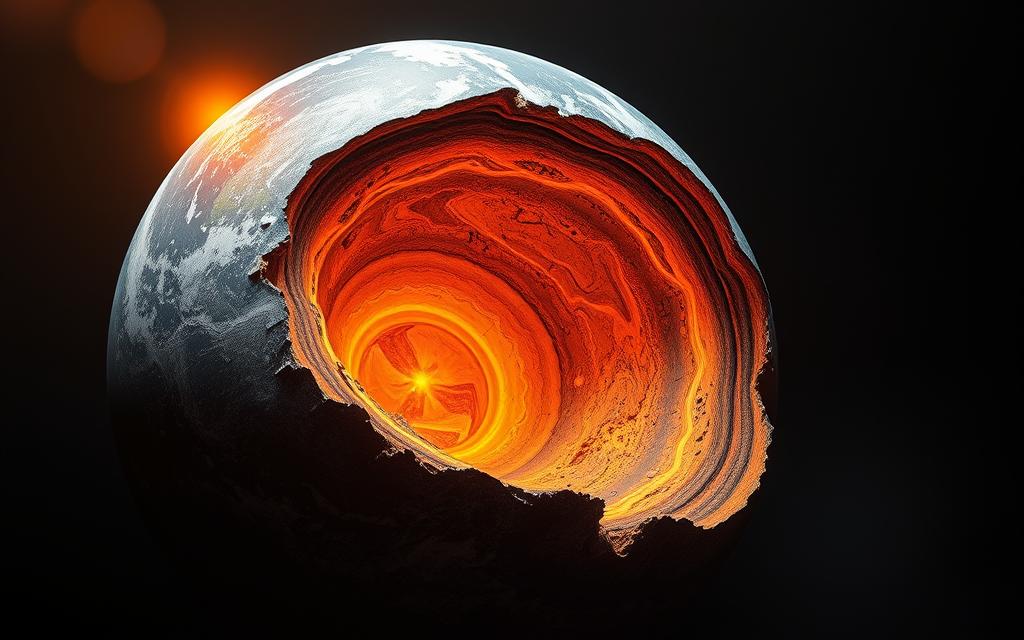Despite humanity’s remarkable achievements in space exploration, the Earth’s interior remains a mystery. While we’ve landed on the moon and sent rovers to Mars, reaching the planet’s core, 4,000 miles below, is still beyond our grasp. “Going inside the Earth is technologically harder than space exploration,” says Vedran Lekić, a seismologist at the University of Maryland.
To understand the Earth’s composition, researchers rely on indirect methods. Seismic waves, generated by earthquakes, provide critical insights into the planet’s structure. Mineral physicists, like Stanford’s Wendy Mao, study volcanic rock samples and simulate extreme pressures to uncover the mantle’s vibrant colors and properties.
The Earth’s interior is divided into four primary layers: the crust, mantle, outer core, and inner core. Each layer has unique characteristics, shaped by immense pressure and heat. By combining seismic data, mineral physics, and magnetic field analysis, scientists piece together the story of our planet’s hidden depths.
Introduction to Earth’s Layers
Beneath our feet lies a complex system of layers, each with unique properties and roles. The Earth’s structure is divided into four primary components: the crust, mantle, outer core, and inner core. These layers vary in thickness, composition, and density, shaping the planet’s dynamic behavior.
The crust is the outermost layer, ranging from 3 to 40 miles in thickness. Oceanic crust is thinner and denser, while continental crust is thicker and less dense. This variability influences tectonic activity and the formation of landforms.
Below the crust lies the mantle, which makes up 84% of the Earth’s volume. Rich in olivine, a green mineral at room temperature, the mantle connects to gemstones like peridot. Under extreme pressure, minerals like bridgmanite and ferropericlase form, revealing the mantle’s vibrant properties. “The mantle’s garnet coloration is a testament to its mineral diversity,” notes Stanford’s Wendy Mao.
The core is divided into two parts: the liquid outer core and the solid inner core. The inner core, roughly 70% the size of the moon, is composed of an iron-nickel alloy. Temperatures here reach 9,800°F, comparable to the sun’s surface. Pressures are so intense that ocean trench pressures seem like “child’s play.”
- The outer core is molten, generating Earth’s magnetic field.
- The inner core remains solid due to extreme pressure.
- Iron and nickel dominate the core’s composition.
Understanding these layers provides insights into the planet’s formation and ongoing processes. From the crust to the core, each layer plays a vital role in shaping Earth’s dynamic nature.
How Do Scientists Learn About the Layers Deep Inside Earth?
Seismic waves act as a window into the Earth’s hidden structure. These waves, generated by earthquakes, travel through the planet, providing crucial data about its composition. “Seismic waves are like the Earth’s natural X-rays,” explains Vedran Lekić, a seismologist at the University of Maryland.
The study of seismic waves travel dates back centuries. Zhang Heng’s ancient seismometer, invented over 2,000 years ago, marked the first attempt to detect ground motion. A pivotal moment came in 1889 when German scientists detected waves from a Japanese quake, revolutionizing seismology.
Seismic Waves: The Earth’s Natural X-Rays
Seismic waves are generated when tectonic plates fracture, releasing energy that travels through the Earth. These waves are categorized into body waves and surface waves. Body waves, including P waves and S waves, provide the most detailed insights into the planet’s interior.
P waves, or primary waves, are compression-first waves that move through both liquid and solid materials. They travel at speeds of 4-7 km/s in the crust, making them the fastest seismic waves. S waves, or secondary waves, move in a shear motion and cannot traverse liquids, such as the outer core.
Types of Seismic Waves: P Waves and S Waves
The discovery of the Mohorovičić discontinuity, a boundary between the crust and mantle, was made possible by analyzing P waves and S waves. This breakthrough highlighted the relationship between wave velocity and density in the Earth’s layers.
- P waves compress and expand materials as they travel.
- S waves move perpendicular to their direction, unable to pass through liquids.
- Seismic tomography, akin to medical CT scans, creates 3D images of the Earth’s interior.
Andrew Campbell from the University of Chicago notes, “The speed of seismic waves reveals the density and composition of the materials they pass through.” This principle continues to guide modern research into the Earth’s hidden depths.
Earthquakes and Seismology
Earthquakes serve as a natural tool for exploring the planet’s hidden structure. By analyzing seismic activity, researchers gain insights into the Earth’s composition and behavior. Modern seismology relies on advanced tools and techniques to decode these natural phenomena.
Recording Seismic Activity
Modern seismometers are incredibly sensitive, detecting vibrations equivalent to atomic-scale movements. These devices use triaxial sensors to measure ground motion in three dimensions. This precision allows scientists to capture even the smallest tremors.
Waveform analysis plays a crucial role in quake localization and magnitude calculation. By studying the shape and timing of seismic waves, researchers can pinpoint the epicenter and assess the event’s intensity. “The accuracy of modern seismometers has revolutionized our understanding of earthquakes,” notes a leading seismologist.
Interpreting Seismic Data
One of the most significant discoveries in seismology is the shadow zone phenomenon. S waves cannot travel through the liquid outer core, creating a zone where they are absent. This observation, first made by Beno Gutenberg, confirmed the core’s liquid nature.
Controlled experiments, such as using air guns or explosions, simulate quakes for detailed study. These methods provide valuable seismic data without relying on natural events. Additionally, seismic tomography uses computer modeling to create 3D maps of the mantle, revealing its complex structure.
- Shadow zones prove the outer core is liquid.
- Controlled experiments offer precise seismic source creation.
- Seismic tomography maps the mantle in three dimensions.
By combining these techniques, scientists refine models of the Earth’s interior, unlocking its deepest secrets.
Mineral Physics and Earth’s Composition
Understanding Earth’s composition requires studying materials from both space and the planet’s surface. Meteorites and volcanic rocks offer valuable insights into the mantle and core. By analyzing these materials, researchers uncover the processes that shaped our planet.
Analyzing Meteorites and Volcanic Rocks
Primitive meteorites, like chondrites, are considered the building blocks of planets. Their composition closely matches the Sun’s elemental inventory, providing clues about Earth’s formation. “Chondritic meteorites are like time capsules from the early solar system,” explains a leading mineral physicist.
Volcanic rocks, particularly xenoliths, are another key resource. These rocks, ejected during eruptions, contain fragments of the mantle. Analyzing their mineralogy helps scientists understand the pressure and temperature conditions deep within the Earth.
Simulating Earth’s Conditions
To replicate the extreme conditions of Earth’s interior, researchers use tools like the diamond anvil cell. This device compresses samples to pressures exceeding 3 million atmospheres. “The diamond anvil cell allows us to study materials under conditions similar to the core,” notes a Stanford researcher.
Experiments with iron and nickel alloys simulate core formation processes. These studies reveal how iron percolates through silicate materials, mimicking the separation of the core from the mantle. Synchrotron X-ray diffraction provides detailed data on phase changes under extreme pressure.
| Tool | Capability | Application |
|---|---|---|
| Diamond Anvil Cell | Compresses samples to 3 million atmospheres | Simulates core and mantle conditions |
| Synchrotron X-ray Diffraction | Analyzes phase changes under pressure | Studies mineral transformations |
| Iron Percolation Experiments | Mimics core separation processes | Explains core-mantle differentiation |
By combining these techniques, scientists refine models of Earth’s composition and dynamic processes. From meteorites to advanced simulations, each method contributes to a deeper understanding of our planet’s hidden depths. For more on Earth’s core, visit this detailed explainer.
Indirect Evidence: Earth’s Magnetic Field
The Earth’s magnetic field serves as a powerful clue to understanding its hidden dynamics. Generated by the motion of liquid iron in the outer core, this field provides indirect evidence of the planet’s internal processes. “The geodynamo theory explains how convection currents in the core create the magnetic field,” notes a leading geophysicist.
Surface measurements show the field’s strength ranges from 25 to 65 microteslas. This variability helps scientists model the core’s composition and behavior. Paleomagnetic records reveal that the field has reversed polarity multiple times, confirming the liquid iron dynamics in the core.
Key insights into the magnetic field include:
- The dynamo effect from convection currents in the outer core sustains the field.
- Field reversals validate the fluid nature of the core and its dynamic processes.
- Magnetometer measurements map variations, aiding in seismic and geomagnetic correlations.
Comparisons with Mars highlight Earth’s unique magnetic shield. While Mars’ field is extinct, Earth’s active field protects the planet from solar radiation. This difference underscores the importance of a molten core in sustaining a magnetic field.
Historically, the magnetic field guided navigation, but today, it helps analyze mantle convection. By studying field orientation, researchers gain insights into the planet’s internal heat flow and tectonic activity. The magnetic field remains a vital tool for unlocking Earth’s deepest secrets.
Conclusion
Exploring the Earth’s hidden depths requires a blend of advanced techniques and collaborative efforts. Seismic imaging, experimental mineralogy, and geomagnetism work together to reveal its complex structure. Despite technological advancements, direct observation remains a challenge, as seen with the Kola Superdeep Borehole’s limited depth.
Ongoing research focuses on ultra-high pressure experiments to simulate conditions found deep within the planet. These studies provide critical insights into the density and composition of materials. Yet, questions about the inner core’s crystal structure remain unresolved, driving further investigation.
Collaboration across disciplines is essential for progress. As Vedran Lekić emphasizes, combining seismic data with laboratory measurements enhances our understanding. Future advancements, such as neutrino-based mapping, promise to uncover even more about the Earth’s interior.
This knowledge not only deepens our understanding of our planet but also informs studies of exoplanet geology. For more on the Earth’s structure, visit this detailed resource.











